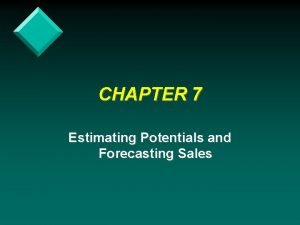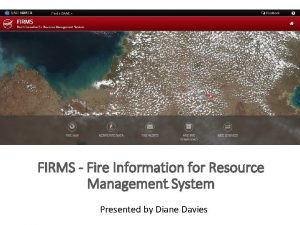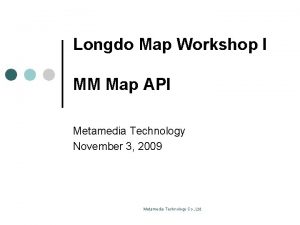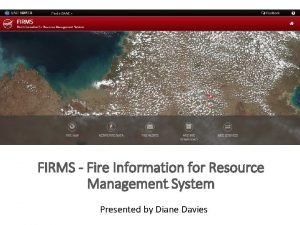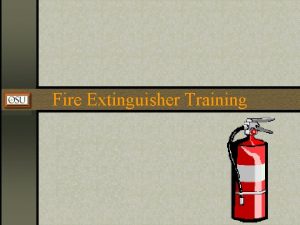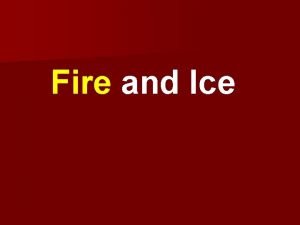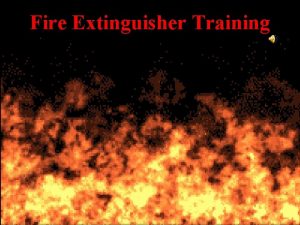SALES MAP Sales Fire Map Overview Sales Fire



















- Slides: 19

SALES MAP

Sales Fire Map Overview Sales Fire Foundations Building Rapport Agenda Pain Budget + Decision Making Closing Out Closing Deal Schedule Next Meeting Presentation/Close Objections

Building Rapport Sales Fire Tips: • • • Focus on building rapport before doing any type of selling People buy emotionally and justify logically It’s not what you say, it’s how you say it Elements of Communication: 55% Body Language, 37% Tonality & 7% Words People like to buy from people who are just like them. (Mirror) Talk Track: You: Hey Tim, it’s really great to talk to you here. How are you doing today? Prospect: I’m doing good, thanks for asking. [small talk] You: Alright, so if you’re ready, how about we go ahead and get started. Prospect: Okay, sounds great.

Agenda Sales Fire Tips: • Fear comes from the unknown, so make sure you’re prospect has nothing to worry about • Setting the Agenda makes the prospect feel like they are in control • I’ll take a “Yes” or “No” but NEVER a “Maybe” Setting the Agenda: Time & Purpose for the Sales Meeting I wanted to take 20 minutes to see if it would make sense to work together. Other Persons’ Expectations & Agenda Of course you’re going to have some questions for me and how our services might be able to help you grow your business. I’ll do my best to answer any questions you may have. Your Expectations & Agenda And naturally, I’ll have some questions for you so I can get a better understanding of how I can best help you. Outcome of Conversation At the end of our call, either 1 of 2 things will happen. If we find it doesn’t make sense to work together that’s totally fine. But if there is a fit, we can work out what the next steps will be towards the end of the call. Does that sound good to you? Challenges & Obstacles (optional): Now a lot of people tell me they’re interested, but after the first meeting, they stop replying to my email and disappear from the face of the earth. So if you’re not interested in my services, I want you to know that you can tell me “No” at any time. Does that sound fair?

Pain Overview Sales Fire Tips: • • • You should be speaking 20% of the time and your prospect 80% of the time Guide the conversation using questions that uncover pain Sometimes you have to make a latent pain into a realized pain Once you find a hint of pain, go DEEP and make it hurt Levels of Pain: Surface > Business > Personal Pain Diagrams:

Pain Steps 1 Sales Fire Pain Steps: �� Why Are They Here: You: Hey Tim, so I’m curious to know what got you interested in taking this call today? Prospect: [may tell you right away what their problems are OR might say a few words and you’ll have to dig deeper] **From here, you’ll go into the Surface Pain Questions** Surface Pain Questions Can you be a little more specific? What exactly do you mean by that? Can you give me an example? How long has this been a challenge? Have you tried anything to fix this?

Pain Steps 2 Sales Fire Pain Steps: �� Present Situation: **Use Present Situation Questions to understand the foundations of their business ** Present Situation Questions What exactly are you selling? Who’s you’re target demographic? What price points do you offer? Why do you think people are buying your product/service? What problem do you think you’re solving for your customers to add value to their lives? What products/services are makes up the majority of your business?

Pain Steps 3 Sales Fire Pain Steps: �� Uncover Deep Pain: **Use Business Pain Questions to uncover their pains and DIVE DEEP ** Business Pain Questions Why do you think that didn’t work? Has anyone tried to do something about this? If you were to take a guess, how much is this costing you? Are you committed to fixing this? If you do nothing, what happens? Personal Pain Questions How does that make you feel? How does this directly effect you? Are you ready to give up? How do you think I might be able to help? Sounds like a major issue, why hasn’t anyone taken care of this?

Pain Steps 4 Sales Fire Pain Steps: �� Desired Situation: **Widen the gap between who they are and who they want to be as far as possible** Desired Situation Questions What does your ideal situation look like? Where do you want to be one year from now. (time duration may vary: 3, 6, or 9 months) Ideally, get the prospect to use tangible numbers. (Example: Generate more sales) What’s your motivation to achieve that goal? How would your life/business be different if you were to reach that goal? Once they tell you, dive deep and explore the vision they have for themselves. Get them to talk about how great their life would be if they achieve their goal. You can also use customer success stories or case studies to further support paint a clearer picture on what they can accomplish. If the prospect is thinking too small, you’re role is to help them dream big! What’s stopping you from getting there now?

Budget Sales Fire Tips: • Remove any negative stigma towards money • If they don’t have a budget, they won’t be able to pay you! Talk Track: **Sumarize 3 to 5 critical pains** You: Okay so like you mentioned, some of the main challenges you’re facing are: • Pain 1 • Pain 2 • Pain 3 You: Is that everything? Prospect: Yeah, I think that’s everything. **If they answer “No”, go back to the pain step and understand what their problems are** **If they answer “Yes”, transition into the budget question** You: Tim, usually when I work with companies like yours they’ll usually have a monthly budget set aside for digital marketing. I was curious to know if this was something you were doing too. Prospect: That makes sense… I have an idea but I haven’t set a concrete budget quite yet. You: Okay that’s totally fine. Now if you were to ballpark how much you were thinking of spending per month on digital marketing, what would that look like? Prospect: Hmmm honestly, I’m not sure. You: Okay no worries. Let’s see if I can help you here. Are you thinking of $1, 000 to $5, 000 or were you thinking of $5, 000 to $10, 000 per month? Prospect: Most likely between the $5, 000 to $10, 000.

Decision Making Sales Fire Tips: • Understand how decision are made with the prospect and their company • Prospects will typically lie. Your role is to get the truth. Talk Track: **Summarize critical pains and budget then transition into the decision making process** You: Tim, so it seems like you have XYZ challenges and have a budget to solve for those challenges. Am I accurate here? So let’s say we could help you, is there anyone else you feel we should involve here? Prospect: No, I’m the decision maker here. OR Prospect: Yes, we need to get my boss on the line. **Regardless of how the prospect answers, ask more questions to fully understand how the decision making process works at their company** You: Okay that’s fine. Is there an ideal time of when you want to talk care of this? **Ask more questions to fully understand the decision making process** Who - who makes the decision, what their roles are, direct or indirect influence? What - what is involved in each decision making step When - when will the decision made (time) Where - what level will the decision be made How - how will the decision be made? Why - why are decisions made this way?

Closing Out: Closing Deal Part 1 Sales Fire Tips: • Closing the deal in 1 sales meeting typically works better for transactional deals • Don’t expect to close a deal in one call with large organizations with many approval processes • This is where you pitch your product/service Talk Track: **First summarize everything you’ve talked about so far and get the prospect to admit that they’re having problems in their own words** You: Alright Tim, so you’re currently making about $20, 000 per month and you believe you can get to $50, 000 a month if you leveraged paid advertising on social. I was curious to know whats stopping you from just doing this on your own? **Listen to their pain problems and get ready to positional yourself as the solution** Prospect: 1) I don’t know how to get there on my own 2) I’d like to get there faster 3) I want a blueprint and guidance from someone who’s successfully done this

Closing Out: Closing Deal Part 2 Talk Track: **Now you want to push the prospect away to get them to sell themselves** You: Making $20, 000 per month doesn’t sound so bad. Why not just stay comfortably where you are? Prospect: Sure it’s a decent amount, but XXX. (goes on rant of why they need to make more money, save more time, etc) You: Okay that makes sense. And could you remind me again when you wanted to take care of this? Prospect: I mean, now is a good time. You: Alright so now we both know what the challenge is and I get that you want to take care of this now. But I got to know, how committed are you to fixing this? **Listen to their pain problems and get ready to position yourself as the solution** Prospect: Oh I’m very committed because I need to YYY.

Closing Out: Closing Deal Part 3 Talk Track: **Get “permission to pitch your product or service and keep your pitch less than 3 minutes** You: Okay Tim, I might be able to help you with that. Are you interested in hearing what I do? Prospect: Please, tell me. **High Level Pitch** You: Great, now what we do is we help [X] accomplish [Y] by doing [Z]. • X = Market • Y = Outcome • Z = Offer You: Great, now what we do is we help high growth startups with product market fit reach new audiences all around the world using Facebook advertising. **Go Deeper into Your Pitch** You: Challenge You: Solution You: Why **After you pitch, the prospect will have more questions for you. Answer all their questions directly without going into technical details. After you answer all of the prospects questions, the conversation will naturally transition into pricing**

Closing Out: Closing Deal Part 4 Talk Track: **If you’re pitch is convincing enough, the prospect will ask about pricing. But if they do not, you can nudge them by asking a transition question** You: With that said, what would you like to do now? (prospect will then ask you how to get started or how they can work with you) **Now use an incentive base pricing strategy to close the prospect** You: Now typically we charge $12, 750, but we’ve found that clients who can make decisions quickly are usually the best ones to work with and achieve the best results. So because of that, we have something called incentive based pricing where we’ll give you a special promotion, lowering the price by $5, 000, and offer our services to you for only $7, 750 if you can make the decision today on this call. **Pause and wait for prospect to respond** Prospect: Okay, sounds fair. How do we get started? You: Great, if you’d like we can go ahead and get started now. Prospect: Sure, but how do we do that exactly? You: If it’s okay with you, we can do credit card over the phone. So is that going to be Visa or Mastercard?

Closing Out: Scheduling Next Meeting Part 1 Sales Fire Tips: • Schedule the next meeting to continue the sales cycle. Typically more common in more complex sales at larger organizations • Make sure both sides have a clear purpose for why scheduling another meeting makes sense Talk Track: **First summarize everything you’ve talked about so far and get the prospect to admit that they’re having problems in their own words** You: Alright Julie, so let me make sure I got everything, and feel free to correct me if I got anything wrong. Right now you team is receiving over +1000 job applications per month, but you’re still reviewing and organizing each application manually. And you’re director is looking to solve this challenge by the end of the quarter and has even allocated a budget of $10, 000 per month for this. Is that everything? Prospect: Yeah, I think that’s everything. You: Okay, great. Now, a lot of companies I work with who also have similar challenges like yours sometimes say they want to fix it, but it can easily end up at the bottom of their priority list. Of course I don’t want to waste your time or mines, so I need to know how committed you are to fixing this? Prospect: Oh I’m very committed to fixing this problem.

Closing Out: Scheduling Next Meeting Part 2 Talk Track: **Get “permission” to pitch your product or service and keep your pitch less than 3 minutes** You: Okay Julie, I might be able to help you with that. Are you interested in hearing what I do? Prospect: Please, tell me. **High Level Pitch** You: Great, now what we do is we help [X] accomplish [Y] by doing [Z]. • X = Market • Y = Outcome • Z = Offer You: Great, now what we do is we help high growth startups with product market fit reach new audiences all around the world using Facebook advertising. **Go Deeper into Your Pitch** You: Challenge You: Solution You: Why **After you pitch, the prospect will have more questions for you. Answer all their questions directly without going into technical details. **

Closing Out: Scheduling Next Meeting Part 3 Talk Track: **If you’re pitch, the prospect will naturally ask you for pricing. But in complex deals, it’s too early to get into pricing because you may not know enough to charge properly** You: Before we dive deeper into pricing, I think it makes sense to see if there is a fit to work together first. Once we know that for sure, I’m sure we can work something out that makes sense for both of us. Does that sound fair? Prospect: Okay, that sounds fair. You: Now from here, what’s the next step to move forward. Prospect: Well, I need to talk to my boss to see what he thinks. Then maybe we can all get on a call? You: Okay that makes sense. Now, do you mind if I make a recommendation? Prospect: Sure. You: Well typically what the next step would be is that: • We’ll schedule a “discovery call” where I’ll get a technical specialists on the line and we’ll go through exactly how your HR system works so we can show you can integrate with…. • We would get everyone involved in deciding if this is a fit or not on a call and… • We would get everyone on a conference call where I’ll do a presentation on exactly how our product/service works based on what you’ve told me so far. • Once you send over the additional information I asked for, I’ll prepare a pricing guide for you and we can discuss all the terms in details on our next call. Prospect: Okay that sounds good to me. You: Okay great. When’s the best time to schedule our next meeting. Prospect: Next week, Monday morning at 10 AM PST. You: Okay great, I’ll send a calendar invite to you and everyone on your team.

Objection Handling Sales Fire Tips: • Don’t think of objections as something negative. It’s an opportunity to understand what’s preventing the prospect from buying • Don’t force it, get the prospect to sell themselves Most Common Objections: Objection: We don’t have the budget. You: Okay I understand where you’re coming from. Now with everything we talked about so far, are you sure this is something you actually want to do? Because if it’s not, that’s totally fine. Prospect: It is. I just don’t have the money right now You: Alright, so what do you need to make this happen? Objection: We don’t have the budget (2). You: Okay that’s fair. I’ve talked to a lot of clients similar to you where there just isn’t any budget right now, and that’s fine. But if it’s okay with you, I just wanted to give you a better sense how we might be able to help you so that in the future we can make time to talk again. Does that sound fair to you? Objection: I need more time before I can make a decision like this. You: Okay that makes sense. How much time do you need? You: Is there anything in particular you need to understand before making a decision? Objection: I need to talk to my wife first. You: Alright, that makes sense. When do you think you’ll be talking to to your wife about this? You: Okay great, I just added you on Facebook/Linked. In so you can reach out to me directly there. And if you can have that conversation and make the decision within the next 24 hours, I promise I’ll hold our special pricing for you
 Prodeploy enterprise suite sales overview
Prodeploy enterprise suite sales overview Reichstag fire who was the fire starter
Reichstag fire who was the fire starter Damper fire alarm
Damper fire alarm Uttar pradesh fire prevention & fire safety rules, 2005
Uttar pradesh fire prevention & fire safety rules, 2005 A-e rwi
A-e rwi Fire definition
Fire definition Product sales force structure example
Product sales force structure example Discuss the nuances of sales letters.
Discuss the nuances of sales letters. Sales force composite
Sales force composite Metode sales force structure
Metode sales force structure Sales quotas and sales territories
Sales quotas and sales territories Fire island map towns
Fire island map towns Firms fire map
Firms fire map Nasa's fire information for resource management system
Nasa's fire information for resource management system A map of the ring of fire
A map of the ring of fire Mmmap
Mmmap Nasa firms fire map
Nasa firms fire map Www overview
Www overview Maximo overview
Maximo overview Universal modeling language
Universal modeling language








